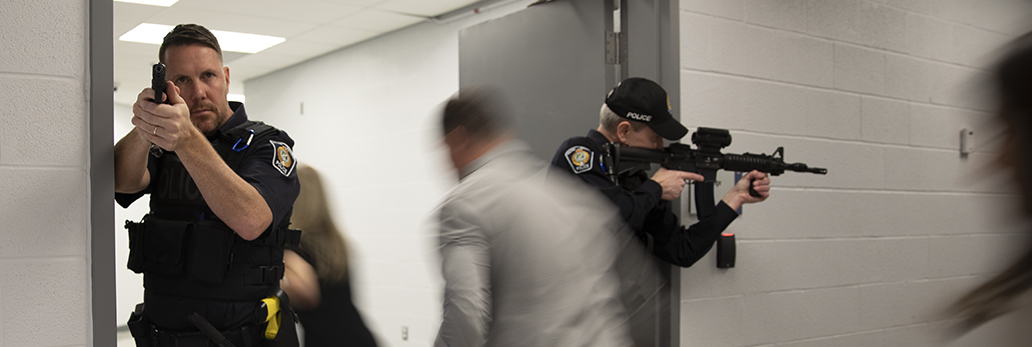
Run – Hide – Defend: Surviving an Active Attacker
The Halton Regional Police Service is committed to ensuring the safety and security of those we serve. Although active attacker incidents are rare, it is important to be prepared for such an event. Knowing what to do and having a plan may ultimately save your life.
The active attacker survival strategy, Run – Hide – Defend, provides an actionable framework that offers the best chance of survival.
We encourage employers and community organizations to familiarize themselves and their staff with the principles of Run – Hide – Defend and to practice what to do in the event such an incident occurs. Preparedness offers the highest chance of survival.
What is an Active Attacker?
An active attacker is defined as an individual actively engaged in killing or attempting to kill people in a confined and populated area. In most cases, active attackers use firearms, knives or other lethal weapons and there often no pattern or method to their selection of victims.
What to do in an Active Attacker Scenario
RUN:
If a safe path is available, do not hesitate – RUN
- Leave all of your belongings
- Escape or evacuate to a safe location
- Discourage others from entering the area
- Do not stop to assist the injured
- Call 9-1-1 when it is safe to do so
HIDE:
If you are not able to escape safely – HIDE
- Stay out of the attacker(s)' view and be quiet
- Silence your phone
- Lock/barricade doors with furniture, etc. and turn off lights
- Hide behind large objects (ideally objects that will protect you from gunfire)
- Call 9-1-1 when it is safe to do so
DEFEND:
If you are confronted by the attacker(s) – DEFEND
- Be prepared to defend yourself with absolute commitment
- Be physical, aggressive, and loud
- Arm yourself with any available weapon (fire extinguisher, chair, etc.)
- Team up with others
- Do whatever it takes to overpower and stop the attacker(s)
- Call 9-1-1 when it is safe to do so
What will the Police Response Look Like?
When police arrive on scene their first priority is to locate and stop the threat. The initial group of responding officers will typically:
- Enter the area in groups of one to four
- Be wearing police and/or tactical uniforms
- Be armed with handguns and/or long guns (rifles or shotguns)
- Move past injured persons as their goal is to locate and stop the attacker(s)
Additional officers may enter the area (after the initial group) and assist in evacuation and providing first aid to injured persons.
What to do When the Police Respond
- Remain calm and quiet and follow directions given by officers
- Raise your hands and keep them visible at all times. Do not have anything in your hands that could be mistaken for a weapon.
- Avoid making quick movements towards officers
Helping Police When they Respond
Officers may ask questions in efforts to locate and stop the threat. Be prepared to provide them with the following:
- Description of the attacker(s) and their last known location
- Number and type(s) of weapon(s) used by the attacker(s)
- Direction of travel of the attacker(s)
- Location and condition of victims
What the Halton Regional Police Service (HRPS) is Doing to Prepare?
- All HRPS officers participate in annual training that specifically deals with active attacker situations
- Training is supplemented with virtual training (i.e. virtual reality). Leveraging this technology allows HRPS officers to train for a variety of active attacker situations in varying locations and conditions
- Long guns and breaching equipment are available to officers in patrol vehicles. This equipment allows officers to respond to incidents more effectively and improves the safety of those involved in an active attacker situation.
- The Critical Infrastructure Police Emergency Response (CIPER) Program is a database of more than 500 locations in the Region of Halton. This database contains details such as floor plans, site plans, satellite imagery, and security information, allowing officers to be better prepared when responding to these locations. Details about CIPER and how to participate in the program can be found here: https://www.haltonpolice.ca/en/staying-safe/ciper.aspx.
Videos
Videos detailing the Run – Hide – Defend strategy, created by York Regional Police Service and Vancouver Police Service, are available to view below:
- Run – Hide – Defend: Surviving an Active Attacker
- Active Deadly Threat
- Run – Hide – Defend PowerPoint Presentation (157MB Download)
Downloadable and Printable Resources
Contact Information
Questions regarding the Run – Hide – Defend active attacker survival strategy can be directed to:
Cst. Steve Elms
Emergency Planner
Steve.Elms@haltonpolice.ca
905-825-4777 ext. 5267
 I Want To
I Want To




 Subscribe to this Page
Subscribe to this Page